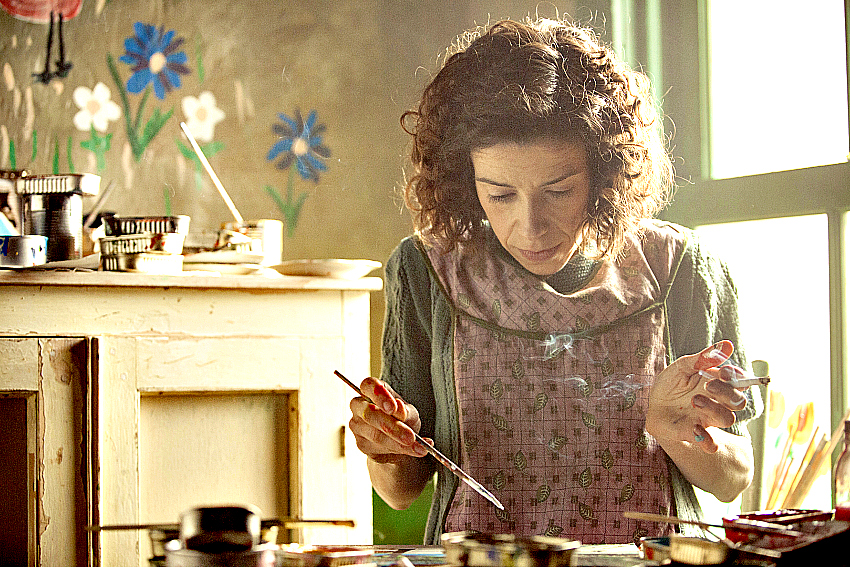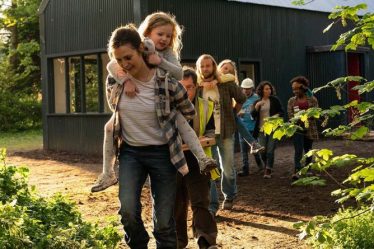

If you are Canadian, and you love art, you’ve heard of Maude Lewis. If you love a story of determination, creativity, and fearlessness, you’ll love “Maudie”, the story of her artistic life that has been brought to the big screen. Helmed by longtime director Aisling Walsh, and starring Sally Hawkins and Ethan Hawke as Maud and Everett Lewis, the film follows the adult experiences and partnership of the folk artist with the recluse who would become her husband and life partner.
Maude Lewis was a self-taught artist that lived through her childhood disfigured, and with an increasingly challenging case of juvenile arthritis. She lived with her family through her twenties, painting every day, but was when her parents both passed away, she was sent to live with her aunt. A yearning for independence led her to answer an ad for a housekeeper. Everett Lewis wanted someone to care for his 10 x 12 foot house, which had neither running water nor electricity, and Maude wanted a sense of belonging and an independence. They married in 1938, and constructed a simple life together where Maude painted every day, and Everett kept house and haggled with tourists and collectors over the price of the originals he sold for her.
Maude had a unique vision where she expressed the joy of simple pleasures and daily life. Over her lifetime, she painted their little house, inside and out, and now that house installed as part of the Maude Lewis exhibit in The Art Gallery of Nova Scotia.
The film, as directed by Walsh, captures the harshness of the environment in which these beautiful, joyful paintings were created, as well as the challenges Maude faced from her physical ailments and from the people around her. It is a slow, lyrical film, more a study in Maudie’s determination and force of will to find joy in every day, and in what is in front of her. The film, in that way, becomes a reminder for us to do so, as well, especially those of us not facing the physical and financial challenges she had.
Hawkins and Hawke, both award-winning actors, turn in great performances, but is is Hawkins as Maude who will be hard to overlook at Oscar season this year. While she is not mimicking the real-life artist, she captures her stubborn optimism and no-nonsense attitude in a way that is inspiring. Never one to play for sympathy, she gives Maude a level of dignity that few other actors could have achieved. Watching old films of the real Maude Lewis, one is struck by how similarly the actress and artist walk and speak, and it is clear Maude found happiness in that little house, just painting every day, a cigarette in one hand, and paintbrush in the other.
There are so few female artists represented on film, and so few naive artists who are revealed to the large art world, it is lovely thing to have this cinematic testament to one of Canada’s greats. If it leads to more interest in and acceptance of the creativity that surrounds us, it is a film that has done a service to us all. It’s unlikely to be a huge, runaway hit that requires theaters from miles around to add showings as happened in Nova Scotia, but it could certainly make a dent in the specialty box office yearly totals.
4 out of 5 stars
An Exclusive interview with director Aisling Walsh:
Cinema Siren: Maudie brings to a wider audience an understanding of this artist that is so important to Canada. This movie is not just as a love story between these two people, and a story about art and creativity but also a love story about Canadians. She is really joyful in her surroundings and her circumstances in just this tiny little house with no heat and yet she was a happy person making do. She was in pain and she’s just made. I feel like Canadians are a little bit like that. They’re pretty easygoing…
Aisling Walsh: They really are. it’s interesting because you know the designer and myself, we’re both Irish and we’re fairly feisty. I feel in your history if you’ve sort of fought for the freedom of a country, it’s very different than if you have been given it, or if you have it, or if you’re there and I suppose a lot of people in Canada going back a couple hundred years, they came from Scotland or Ireland or Europe, but hadn’t fought for it. Then you have the weather, which is a huge factor. People have to get along, you know. They have to help each other survive, and they have to dig each other out of snow. The thing that’s amazing about them is they respond to weather like I’ve never had to do my life. They go through feet of snow to go do whatever they have to do. That’s such a part of their lives. Like putting a log on the fire and getting up at six o’clock in the morning, right, because they’ve got to keep this fire going. It’s so much a part of their lives, and they spend many hours in their homes during the winter, because it’s too cold to go out. I come from a climate where there’s not a day you couldn’t even consider going out. It makes them learn to be very contented in a way. They’ve got to live in their own surroundings, and they’ve got to live with other people, and you know they live in that kind of small society. How did two people live in a 12×12 foot shack for 35 years, not accepted in society, they have to live their lives themselves. and yet she was very content you know.
CS: And speaks it through her work, you can really see her contentment though her work. With some naive artists you see the darkness and some of the struggle in the work. With her there’s a purity, not just of the subject matter, but of the perspective and the color she chooses. I think that’s what separates her from other naïve artists of the same area or style.
AW: Her work is very uplifting and there isn’t darkness in it, no. And she doesn’t go to those dark places you know, her paintings are often described as having no shadows, there’s no darkness. It’s children going to school, kids skiing down hills, the oxen, the cats… I think that’s how she saw the world, she saw the positivity and the kind of beauty in it you know.
CS: I read love Andrew Wyeth and were inspired by him in the work of this particular film. Not so light, that one.
AW: I’m not saying his work is simple in any way, but there is a beautiful vision of landscape in his work. He also uses great texture…. We used a quilt but actually for the bedroom, it is patchwork quilt on the bed and it’s light and dark. His light and darkness I really like too, and also he paints in all the seasons. His composition is much darker than her world, but it was a real help to have a reference to start from. The other reference for me was Dorothea Lange, a photographer whose work I love, because you can see the texture, and you can see the filth of the dirt, and the worn clothes… just such beautiful portraits of people.
You see in the film actually, there’s a lovely photograph of a couple, they have a knapsack one of the guys walking past a sign. I used that in the film. They’re just good references to start from, and Maude’s work, it’s much more uplifting than that, but I needed to start in a place where for me made sense. We didn’t experience the depression quite like they did in America or Canada. I mean you think of American in the 20th century, I’m not saying everywhere was wealthy but there was this huge vast wealth, as well as in Canada, and suddenly it was gone. Lange’s photographs really depict that incredibly well. They are amazing portraits of people and you can see finery, you can see fine people that are obviously quite well off, in their little trucks probably driving across California or wherever they’re going. And they’ve gone from being rich to just trying to keep alive.
CS: I know there are paintings she altered slightly but painted again and again. You can’t go 365 days a year for many years without repeating images. I love the cat paintings, but I think i’ve seen a number of them…
AW: She had a cat called Fluffy. You see her as a child and the cat was called Fluffy and I think that’s why I like them, it’s related back to that, it’s her childhood. She painted a white cat quite a bit that I think is really more emotional… I would say that’s fluffy. So for me I prefer the cats to the oxen. The oxen are kind of different, they are more landscape…The cats somehow for me relate to her much more and the flowers and the birds too, all of that.
CS: I was struck, when I watched footage of the real Maudie, how spot-on Sally was in her portrayal.
AW: Yeah, in just little things like the silhouette. There’s a photograph of Maude and she’s quite bent over, she’s at the door, and Everett is outside, standing with logs. She got that, Sally got that. We got it, and not that that’s important, but somehow she can go there. We have no photographs of her as a young woman, the photographs of her are in the last of the three years of her life. So it’s exciting to journey back to the beginning, and how she got there. Nobody knows what the first thing she painted on the wall was, we had to work that out. That was the kind of fun part about it. It’s with her finger because she had no brushes, and it’s one very simple tree and you can see it around the side of the house. There are things that she discovered along the filming, and then she just became it.
We were very detailed, both Sally and I, like, how did she walk in the beginning, how does that develop as an older woman? I think she really achieved that, and then with little things like as an older woman, she always wore those aprons… so we had an apron made. People had their clothes for twenty years and thirty years then. And then she had a lovely brooch, we found one online and used that but those little things were important for me and for Sally.
CS: What was one thing someone told you about Maude in all the interviews you did that surprised or moved you?
AW: I think one of the saddest things was a guy who remembered her… well two things, he remembered her as an older woman walking home and kids still throwing stones at her, and her standing at Christmas time in Digby in the cold, trying to sell her pictures. But then there were people who remember this remarkable spirit. That she was a wonderful woman when you got to know her. There is a lovely letter that this gentleman showed me that she wrote. She’s wrote a lot of letters, like the Nixon paintings for example. She sent him a note that said “I’m so happy you like painting, I didn’t have very much in stock and so I thought this one might be kind of quite perfect for you, hope you enjoy.” She wasn’t as isolated maybe as we imagine.
AW: Guy Godfree, the DOP and John Hand, the production designer and I all worked in the same room together. What I usually do anyway is try to work in the same room that the designer is working in. But it was great to see how attached we all got to Maude and who she was. Arguing…Everybody kind of fights for Maude. It’s amazing how people get so passionate about a project they’re working on. I’d worked with John quite a bit but Guy was the new kid on the block and it was important for me, very important that they get on.
When Sally had to catch the chicken, in that scene it was John, the production designer, that showed her how to do it, because he is from the countryside. So it was everybody working together as well, nobody was precious about “oh, that’s my bit” and “I want to do that bit”. All of those things matter in a film like this.



